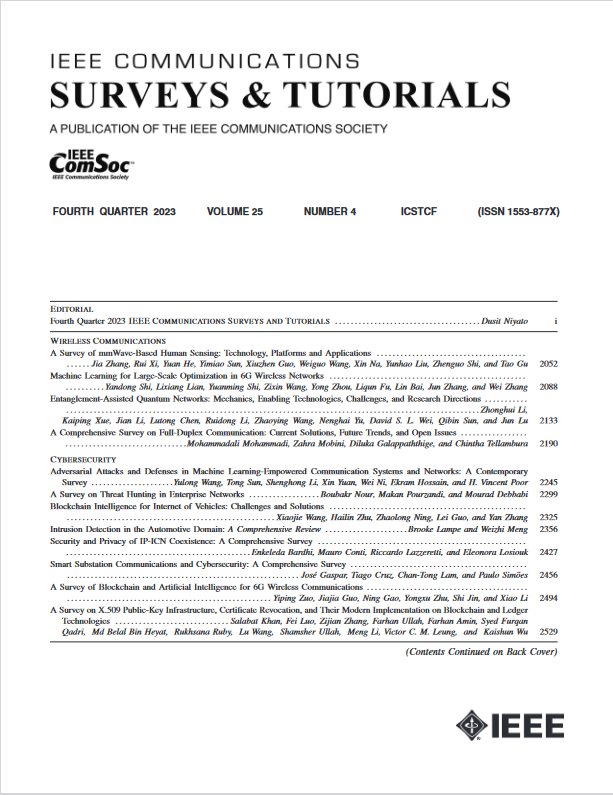Evolution of High-Throughput Satellite Systems: A Vision of Programmable Regenerative Payload
IF 34.4
1区 计算机科学
Q1 COMPUTER SCIENCE, INFORMATION SYSTEMS
引用次数: 0
Abstract
High-throughput satellite (HTS), with its digital payload technology, is expected to play a key role as an enabler of the upcoming sixth-generation (6G) networks. HTS is mainly designed to provide higher data rates and capacities. Fueled by technological advancements, including beamforming, advanced modulation techniques, reconfigurable phased array technologies, and electronically steerable antennas, HTS has emerged as a fundamental component for future network generations. This paper offers a comprehensive state-of-the-art on HTS systems, focusing on standardization, patents, channel multiple access techniques, routing, load balancing, and the role of software-defined networking (SDN). In addition, we provide a vision for next-generation satellite systems that we have named Extremely-HTS (EHTS) toward autonomous satellites supported by the main requirements and key technologies expected for these systems. The EHTS system will be designed to maximize spectrum reuse and data rates and to flexibly steer the capacity to satisfy user demand. We introduce a novel architecture for future programmable regenerative payloads as well.高通量卫星系统的演变:可编程再生有效载荷的愿景
高通量卫星(HTS)凭借其数字有效载荷技术,有望在即将到来的第六代(6G)网络中发挥关键作用。HTS的主要目的是提供更高的数据速率和容量。在技术进步的推动下,包括波束成形、先进调制技术、可重构相控阵技术和电子可操纵天线,高温超导已经成为未来几代网络的基本组成部分。本文提供了关于HTS系统的综合最新技术,重点是标准化、专利、信道多址技术、路由、负载平衡和软件定义网络(SDN)的作用。此外,我们还为下一代卫星系统提供了一个愿景,我们将其命名为extreme - hts (EHTS),即由这些系统预期的主要要求和关键技术支持的自主卫星。EHTS系统的设计将最大限度地提高频谱重用和数据速率,并灵活地控制容量以满足用户需求。我们还介绍了未来可编程再生有效载荷的新架构。
本文章由计算机程序翻译,如有差异,请以英文原文为准。
求助全文
约1分钟内获得全文
求助全文
来源期刊

IEEE Communications Surveys and Tutorials
COMPUTER SCIENCE, INFORMATION SYSTEMS-TELECOMMUNICATIONS
CiteScore
80.20
自引率
2.50%
发文量
84
审稿时长
6 months
期刊介绍:
IEEE Communications Surveys & Tutorials is an online journal published by the IEEE Communications Society for tutorials and surveys covering all aspects of the communications field. Telecommunications technology is progressing at a rapid pace, and the IEEE Communications Society is committed to providing researchers and other professionals the information and tools to stay abreast. IEEE Communications Surveys and Tutorials focuses on integrating and adding understanding to the existing literature on communications, putting results in context. Whether searching for in-depth information about a familiar area or an introduction into a new area, IEEE Communications Surveys & Tutorials aims to be the premier source of peer-reviewed, comprehensive tutorials and surveys, and pointers to further sources. IEEE Communications Surveys & Tutorials publishes only articles exclusively written for IEEE Communications Surveys & Tutorials and go through a rigorous review process before their publication in the quarterly issues.
A tutorial article in the IEEE Communications Surveys & Tutorials should be designed to help the reader to become familiar with and learn something specific about a chosen topic. In contrast, the term survey, as applied here, is defined to mean a survey of the literature. A survey article in IEEE Communications Surveys & Tutorials should provide a comprehensive review of developments in a selected area, covering its development from its inception to its current state and beyond, and illustrating its development through liberal citations from the literature. Both tutorials and surveys should be tutorial in nature and should be written in a style comprehensible to readers outside the specialty of the article.
 求助内容:
求助内容: 应助结果提醒方式:
应助结果提醒方式:


